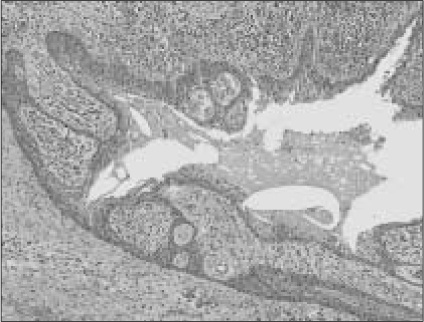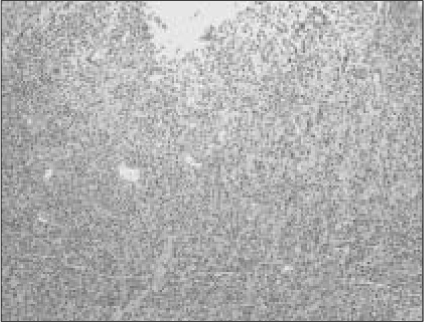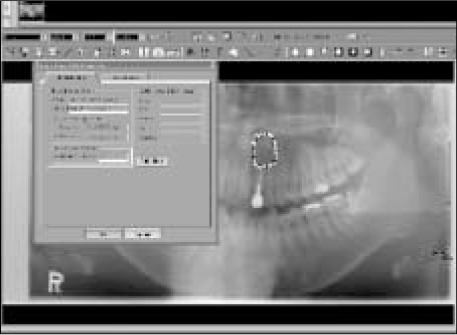J Korean Acad Conserv Dent.
2010 Jan;35(1):24-29. 10.5395/JKACD.2010.35.1.024.
The relationship of radiographic lesion size and characteristics to diagnosis of periapical cysts and granulomas
- Affiliations
-
- 1Department of Conservative Dentistry, School of Dentistry, Seoul National University, Korea. shbaek@snu.ac.kr
- KMID: 2176274
- DOI: http://doi.org/10.5395/JKACD.2010.35.1.024
Abstract
- The purpose of this study was to find out the relationship of radiographic lesion size, gender, age of patients and radiographic character to the diagnosis of periapical cyst and granuloma. The data was collected from 187 periapical lesions of 167 patients who undergone apical surgery at Department of Conservative Dentistry, Seoul National University Dental Hospital from 2003 to 2005. The lesion were surgically removed and send for biopsy to the Oral Pathology Laboratory. From the initial radiograph, lesion size was calculated using PiViewSTAR(R) (INFINITT, Korea) program. The obtained data were statistically evaluated using SPSS (p < 0.05). The result were as followings: 1. From 187 biopsy samples, the incidence of periapical cyst was 28.34% and granuloma was 65.24%. 2. There was a significant correlation between periapical cyst and the size of radiographic lesion (p < 0.01). 3. There were no significant correlations between age, gender, location of lesion and the final diagnosis (p > 0.05). 4. There was a significant correlation between the non-demarcation of the lesion and the incidence of periapical granuloma (p < 0.01).
Figure
Reference
-
1. Natkin E, Oswald RJ, Carnes LI. The relationship of lesion size to diagnosis, incidence, and treatment of periapical cysts and granulomas. Oral Surg. 1984. 57:82–93.
Article2. Nair PNR. New perspectives on radicular cysts: do they heal? Int Endod J. 1998. 31:155–160.
Article3. Bhaskar SN. Nonsurgical resolution of radicular cysts. Oral Surg. 1972. 34:458–468.
Article4. Malassez ML. Sur l'existence de masses épithéliales dans le ligament alvéolodentaire chez l'homme adulte et à l'état normal. Com Rend Soc Biol. 1884. 36:241–244.5. Torabinejad M, Kettering J. Identification and relative concentration of B and T lymphocytes in human chronic periapical lesions. J Endod. 1985. 11:122–125.
Article6. Bohne W. Light and ultrastructural studies on human chronic periapical lesions. J Oral Pathol Med. 1990. 19:215–220.
Article7. Cho SJ, Yoon TC, Park DS. A quantitative analysis of the immunoglobulin containing cells in periapical lesions of the human teeth. J Korean Acad Conserv Dent. 1995. 20:55–70.8. Baek SH, Lim SS. An immunohistochemical study on the immunoglobulin g subclasses of the experimentally induced rat pulp and periapical pathoses. J Korean Acad Conserv Dent. 1991. 16(1):41–59.9. Boo JS, Lim SS. An immunohistochemical study on the immunoglobulins of experimentally induced rat periapical lesions. J Korean Acad Conserv Dent. 1990. 15(2):58–75.10. Langeland K, Block RM, Grossman L1. A histopathologic and histobacteriologic study of 35 periapical endodontic surgical specimens. J Endod. 1977. 3:8–23.
Article11. Yanagisawa S. Pathologic study of periapical lesions 1. Periapical granulomas: clinical, histopathologic and immunohistopathologic studies. J Oral Pathol. 1980. 9:288–300.
Article12. Skaug N, Nilsen R, Matre R, Bernhoff CH, Johannessen AC. In situ characterization of cell infiltrates in human dental periapieal granulomas. J Oral Pathol. 1982. 11:47–57.
Article13. McCall JO, Wald SS. Clinical Dental Roentgenology. 1952. 3rd ed. Philadelphia, PA: WB Saunders Co.;192.14. Lalonde ER. A new rationale for management of periapical granulomas and cysts. An evaluation of histopathological and radiographic findings. J Am Dent Assoc. 1970. 80:1056–1059.
Article15. Sommer RF, Ostrander FD, Crowley MC. Clinical Endodontics. 1956. 1st ed. Philadelphia, PA: WB Saunders Co.;424–426.16. Bhaskar SN. Periapical lesions-types, incidence and clinical features. Oral Surg. 1966. 21:657–671.17. Forsberg A, Hagglund F. Diffrential diagnosis of radicular cyst and granuloma: Use of X-ray contrast medium. Dent Radiogr Photogr. 1960. 33:84–88.18. Toller PA. Protein substances in odontogenic cyst fluids. Br Dent J. 1970. 128:317–322.
Article19. Morse DR, Patnik JW, Schacterle GR. Electrophoretic diffrentiation of radicular cyst and granulomas. Oral Surg. 1973. 35:249–264.20. Morse DR, Schacterle GR, Wolfson EM. A rapid chairside diffrentiation of radicular cysts and granulomas. J Endod. 1976. 2:17–20.21. Grossmann LI. Root Canal Therapy. 1950. 3rd ed. Philadelphia, PA: Lea & Febiger;99.22. Baumann L, Rossmann SR. Clinical roentgenologic and histopathologic findings in teeth with apical radiolucent areas. Oral Surg. 1956. 9:1330–1336.
Article23. Linenberg WB, Waldron CA, De Laune GF Jr. A clinical, roentgenographic and histopathologic evaluation of periapical lesions. Oral Surg. 1964. 17:467–472.
Article24. Patterson SS, Shafer WG, Healey HJ. Periapical lesions associated with endodontically treated teeth. J Am Dent Assoc. 1964. 68:191–194.
Article25. Block RM, Bushell A, Rodrigues H, Langeland K. A histopathological, histobacteriologic and radiographic study of periapical endodontic surgical specimens. Oral Surg. 1976. 42:656–678.
Article26. Stafne EC. Oral roentgenographic and direct observation of experimental lesions in bone. J Am Dent Assoc. 1961. 62:708–716.27. Sommer R. Clinical evaluation of diagnostic aids. D. Radiog. and Patholog. 1954. 27:17–18.28. Preibe WA, Lazansky JP, Wuehrmann AH. The Value of the roentgenographic film in the diffrential diagnosis of periapical lesions. Oral Surg Oral Med Oral Pathol. 1954. 7:979–983.
- Full Text Links
- Actions
-
Cited
- CITED
-
- Close
- Share
- Similar articles
-
- A Clinical Study of Periapical Lesions
- Comparison of digital radiometric featuresbetween radicular cysts and periapical granulomas
- Evaluation of ultrasonography as a diagnostic tool in the management of periapical cysts and granulomas: A clinical study
- Interplay of collagen and mast cells in periapical granulomas and periapical cysts: a comparative polarizing microscopic and immunohistochemical study
- Unicystic Ameloblastoma Presenting As A Radicular Cyst




